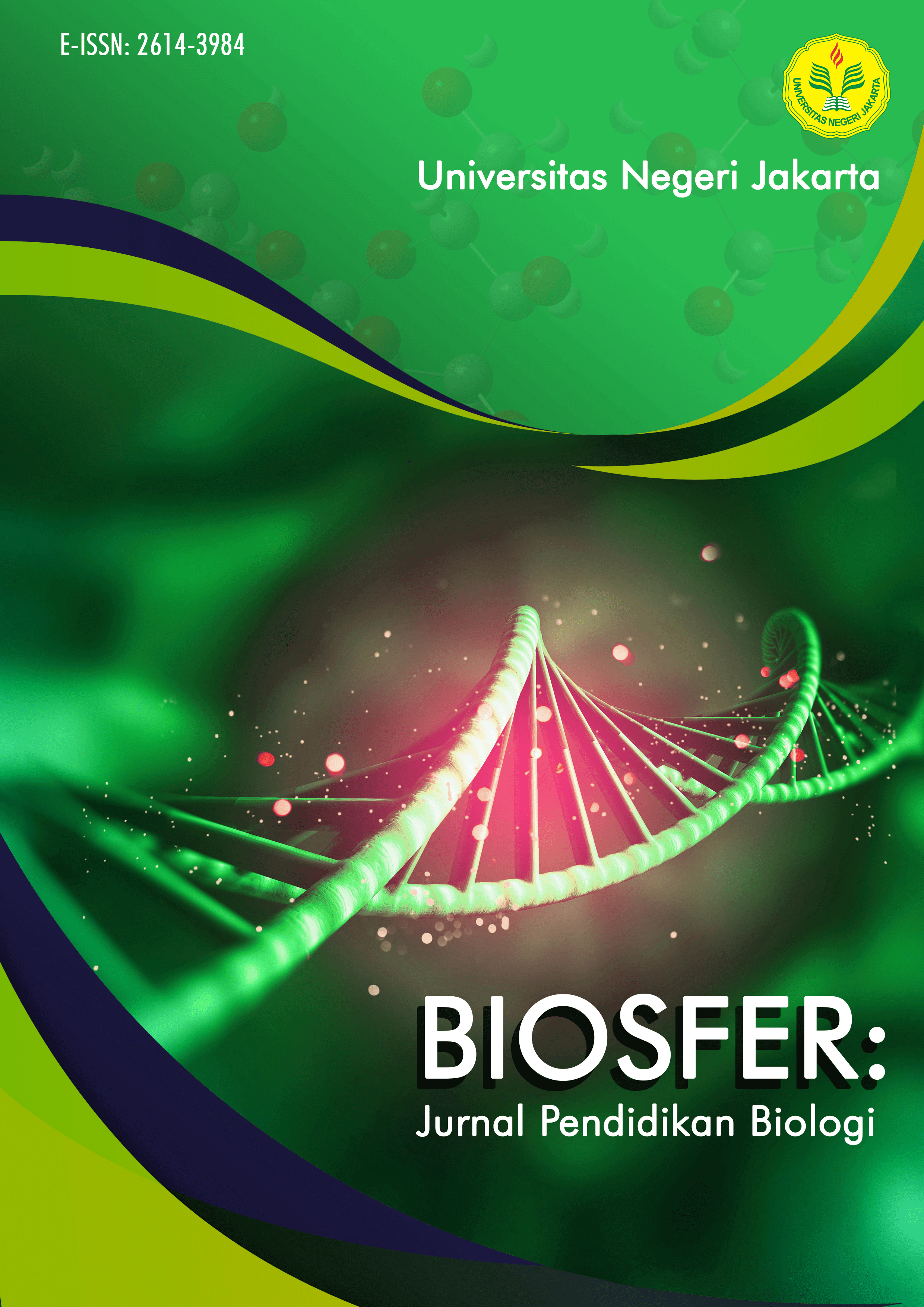The effect of augmented reality application (ARSINAPS) on learning motivation and outcomes in biology
DOI:
https://doi.org/10.21009/biosferjpb.37752Keywords:
ARSINAP, Augmented Reality, Motivation, Learning OutcomeAbstract
This study aims to determine the effectiveness of using the ARSINAPS mobile augmented reality application on learning motivation and outcomes in high school and biology education students. The method used in this study was quasi-experimental with a post-test control group design. The research sample consisted of two experimental classes and two control classes from three schools in the Jakarta, Bekasi, and Tangerang areas, totalling 140 students, and from the college level, consisting of one experimental class and one control class, totalling 68 students. The data obtained were in the form of learning outcomes in the respiratory system and learning motivation scores in biology learning. The average high school-level motivation score in the control class was 85.99, and the overall average for learning outcomes was 77.33 and 63.05. Based on the results of the data calculations, the application effectively improves students’ learning outcomes at the high school and undergraduate levels
References
Azuma, R. T. (1999). The challenge of making augmented reality work outdoors. The 1st International Symposium on Mixed Reality (ISMR99). https://ronaldazuma.com/papers/ismr99.pdf
Bacca, J., Baldiris, S., Fabregat, R., & Kinshuk. (2018). Insights into the factors influencing student motivation in Augmented Reality learning experiences in Vocational Education and Training. Frontiers in Psychology, 9(AUG). https://doi.org/10.3389/fpsyg.2018.01486
Cai, S., Chiang, F.-K., Sun, Y., Lin, C., & Lee, J. J. (2017). Applications of augmented reality-based natural interactive learning in magnetic field instruction. Interactive Learning Environments, 25(6), 778–791. https://doi.org/10.1080/10494820.2016.1181094
Chen, C. M., & Tsai, Y. N. (2012). Interactive augmented reality system for enhancing library instruction in elementary schools. Computers & Education, 59(2), 638–652. https://doi.org/10.1016/j.compedu.2012.03.001
Chiang, T. H. C., Yang, S. J. H., & Hwang, G.-J. (2014). An Augmented Reality-based Mobile Learning System to Improve Students’ Learning Achievements and Motivations in Natural Science Inquiry Activities. Journal of Educational Technology & Society, 17(4), 352–365. https://www.jstor.org/stable/jeductechsoci.17.4.352
Chien, Y. C., Su, Y. N., Wu, T. T., & Huang, Y. M. (2019). Enhancing students’ botanical learning by using augmented reality. Universal Access in the Information Society, 18(2), 231–241. https://doi.org/10.1007/s10209-017-0590-4
De Paolis, L. T., & Mongelli, A. (Eds.). (2016). Augmented Reality, Virtual Reality, and Computer Graphics (Vol. 9769). Springer International Publishing. https://doi.org/10.1007/978-3-319-40651-0
Erbas, C., & Demirer, V. (2019). The effects of augmented reality on students’ academic achievement and motivation in a biology course. Journal of Computer Assisted Learning, 35(3), 450–458. https://doi.org/10.1111/jcal.12350
Garzón, J., Pavón, J., & Baldiris, S. (2019). Systematic review and meta-analysis of augmented reality in educational settings. Virtual Reality, 23(4), 447–459. https://doi.org/10.1007/s10055-019-00379-9
Hurst, W. (2020). VISUAL 2019 The Fourth International Conference on Applications and Systems of Visual (Issue April).
Ibáñez, M. B., Uriarte Portillo, A., Zatarain Cabada, R., & Barrón, M. L. (2020). Impact of augmented reality technology on academic achievement and motivation of students from public and private Mexican schools. A case study in a middle-school geometry course. Computers and Education, 145, 103734. https://doi.org/10.1016/j.compedu.2019.103734
Jamali, S. S. (2017). An investigation of mobile augmented reality‐based learning features in cognitive and affective environments. Murdoch University.
Kaufmann, H. (2003). Collaborative Augmented Reality in Education. Learning, March 2003, 1–16. http://citeseerx.ist.psu.edu/viewdoc/download?doi=10.1.1.12.2215&rep=rep1&type=pdf%5Cnhttp://www.mendeley.com
Khan, T., Johnston, K., & Ophoff, J. (2019). The Impact of an Augmented Reality Application on Learning Motivation of Students. Advances in Human-Computer Interaction, 2019. https://doi.org/10.1155/2019/7208494
Liono, R. A., Amanda, N., Pratiwi, A., & Gunawan, A. A. S. (2021). A Systematic Literature Review: Learning with Visual by the Help of Augmented Reality Helps Students Learn Better. Procedia Computer Science, 179, 144–152. https://doi.org/10.1016/j.procs.2020.12.019
Lu, S., & Liu, Y.-C. (2015). Integrating augmented reality technology to enhance children’s learning in marine education. Environmental Education Research, 21(4), 525–541. https://doi.org/10.1080/13504622.2014.911247 CrossMark LogoCrossMark
Muñoz-Cristóbal, J. A., Jorrín-Abellan, I. M., Asensio-Peréz, J. I., Martínez-Monés, A., Prieto, L. P., & Dimitriadis, Y. (2015). Supporting teacher orchestration in ubiquitous learning environments: A study in primary education. IEEE Transactions on Learning Technologies, 8(1), 83–97. https://doi.org/10.1109/TLT.2014.2370634
Nechypurenko, P. P., Starova, T. V., Selivanova, T. V., Tomilina, A. O., & Uchitel, A. D. (2018). Use of augmented reality in chemistry education. CEUR Workshop Proceedings, 2257, 15–23. https://doi.org/10.31812/pedag.v51i0.3650
Rini, D. S., Azrai, E. P., Suryanda, A., Inayah, S. S., Khansa, A. A., & Kurnianto, M. B. (2022). Augmented reality (AR) technology on the android operating system in human respiratory system: From organ to cell. Biosfer, 15(1), 25–35. https://doi.org/10.21009/biosferjpb.23448
Rodríguez-Abad, C., Fernández-De-la-iglesia, J. D. C., Martínez-Santos, A. E., & Rodríguez-González, R. (2021). A systematic review of augmented reality in health sciences: A guide to decision-making in higher education. In International Journal of Environmental Research and Public Health (Vol. 18, Issue 8). MDPI. https://doi.org/10.3390/ijerph18084262
Safadel, P., & White, D. (2019). Facilitating Molecular Biology Teaching by Using Augmented Reality (AR) and Protein Data Bank (PDB). TechTrends, 63(2), 188–193. https://doi.org/10.1007/s11528-018-0343-0
Tarng, W., Ou, K.-L., Lu, Y.-C., Shih, Y.-S., & Liou, H.-H. (2018). A Sun Path Observation System Based on Augment Reality and Mobile Learning. Mobile Information Systems, 2018, 1–10. https://doi.org/10.1155/2018/5950732
Thomas, B. H. (2007). Emerging Technologies of Augmented Reality. In Emerging Technologies of Augmented Reality: Interfaces and Design. http://www.scopus.com/inward/record.url?eid=2-s2.0-84901571644&partnerID=tZOtx3y1
Weng, N., Bee, O., Yew, L., & Hsia, T. (2017). An Augmented Reality System for Biology Science Education in Malaysia. International Journal of Innovative Computing, 6(2), 8–13. https://doi.org/10.11113/ijic.v6n2.128
Wu, H. K., Lee, S. W. Y., Chang, H. Y., & Liang, J. C. (2013). Current status, opportunities and challenges of augmented reality in education. Computers and Education, 62, 41–49. https://doi.org/10.1016/j.compedu.2012.10.024
Zhang, H., Zhang, J., Yin, X., Zhou, K., & Pan, Z. (2020). Cloud-to-end Rendering and Storage Management for Virtual Reality in Experimental Education. Virtual Reality & Intelligent Hardware, 2(4), 368–380. https://doi.org/10.1016/j.vrih.2020.07.001
Downloads
Published
How to Cite
Issue
Section
License
The Authors submitting a manuscript do so on the understanding that if accepted for publication, copyright of the article shall be assigned to Biosfer: Jurnal Pendidikan Biologi (Biosferjpb) and Departement of Biology Education, Universitas Negeri Jakarta as publisher of the journal.



